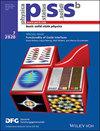Advantages of Ultrathin AlN/GaN/AlN Quantum Wells for Excitonic Population Distribution and Transition Features Studied by Phononic–Excitonic–Radiative Model
IF 1.8
4区 物理与天体物理
Q3 PHYSICS, CONDENSED MATTER
引用次数: 0
Abstract
Excitons are expected to be a high‐efficiency emission source in UV light‐emitting devices. However, the damping of the excitonic laser oscillation has been reported under conditions where the excitonic states are expected to be populated in the conventional theory. In order to understand the exciton dynamics under the thermal nonequilibrium state, a theoretical model including various energy species in semiconductors such as electrons, phonons, and photons is required. Herein, a 2D phononic–excitonic–radiative model is constructed to analyze the exciton dynamics in a 2D system. 2D excitons with four principal quantum number states and the continuum in the lowest energy level of the AlN/GaN/AlN quantum wells are considered. It is found that the 2D phonon significantly augments the excitation transition rate. When the high recombination rate corresponding to stimulated emission is considered, the exciton binding energy of 108 meV is not enough to reduce the population in the high‐order discreet states and the continuum states, while the binding energy of 215 meV corresponding to the one monolayer GaN has an advantage of reducing these populations. The analysis of population flux has an advantage in discussing the increase in the kinetic energy transfer to the 1利用声子-激子-辐射模型研究超薄 AlN/GaN/AlN 量子阱在激子种群分布和转变特征方面的优势
激子有望成为紫外发光器件中的高效发射源。然而,根据传统理论,在激子态填充的条件下,激子激光振荡会出现阻尼。为了理解热非平衡态下的激子动力学,需要一个包含半导体中各种能量物种(如电子、声子和光子)的理论模型。本文构建了一个二维声子-激子-辐射模型来分析二维系统中的激子动力学。该模型考虑了具有四个主量子数态的二维激子以及 AlN/GaN/AlN 量子阱最低能级中的连续体。研究发现,二维声子大大提高了激发转变率。当考虑到与受激发射相对应的高重组率时,108 meV 的激子结合能不足以减少高阶离散态和连续态中的种群,而与单层 GaN 相对应的 215 meV 结合能则具有减少这些种群的优势。对种群通量的分析有利于讨论向 1S 激子转移动能的增加。
本文章由计算机程序翻译,如有差异,请以英文原文为准。
求助全文
约1分钟内获得全文
求助全文
来源期刊
CiteScore
3.30
自引率
6.20%
发文量
321
审稿时长
2 months
期刊介绍:
physica status solidi is devoted to the thorough peer review and the rapid publication of new and important results in all fields of solid state and materials physics, from basic science to applications and devices. Being among the largest and most important international publications, the pss journals publish review articles, letters and original work as well as special issues and conference contributions.
physica status solidi b – basic solid state physics is devoted to topics such as theoretical and experimental investigations of the atomistic and electronic structure of solids in general, phase transitions, electronic and optical properties of low-dimensional, nano-scale, strongly correlated, or disordered systems, superconductivity, magnetism, ferroelectricity etc.

 求助内容:
求助内容: 应助结果提醒方式:
应助结果提醒方式:


